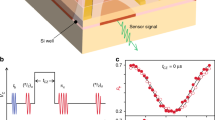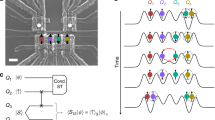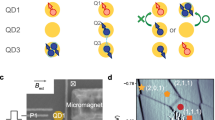Abstract
Measurements of quantum systems inevitably involve disturbance in various forms. Within the limits imposed by quantum mechanics, there exists an ideal projective measurement that does not introduce a back action on the measured observable, known as a quantum non-demolition (QND) measurement1,2. Here we demonstrate an all-electrical QND measurement of a single electron spin in a gate-defined quantum dot. We entangle the single spin with a two-electron, singlet–triplet ancilla qubit via the exchange interaction3,4 and then read out the ancilla in a single shot. This procedure realizes a disturbance-free projective measurement of the single spin at a rate two orders of magnitude faster than its relaxation. The QND nature of the measurement protocol5,6 enables enhancement of the overall measurement fidelity by repeating the protocol. We demonstrate a monotonic increase of the fidelity over 100 repetitions against arbitrary input states. Our analysis based on statistical inference is tolerant to the presence of the relaxation and dephasing. We further exemplify the QND character of the measurement by observing spontaneous flips (quantum jumps)7 of a single electron spin. Combined with the high-fidelity control of spin qubits8,9,10,11,12,13, these results will allow for various measurement-based quantum state manipulations including quantum error correction protocols14.
This is a preview of subscription content, access via your institution
Access options
Access Nature and 54 other Nature Portfolio journals
Get Nature+, our best-value online-access subscription
$29.99 / 30 days
cancel any time
Subscribe to this journal
Receive 12 print issues and online access
$259.00 per year
only $21.58 per issue
Buy this article
- Purchase on Springer Link
- Instant access to full article PDF
Prices may be subject to local taxes which are calculated during checkout




Similar content being viewed by others
Data availability
The data that support the plots within this paper and other findings of this study are available from the corresponding author upon reasonable request.
References
Grangier, P., Levenson, J. A. & Poizat, J. P. Quantum non-demolition measurements in optics. Nature 396, 537–542 (1998).
Imoto, N., Haus, H. H. A. & Yamamoto, Y. Quantum nondemolition measurement of the photon number via the optical Kerr effect. Phys. Rev. A 32, 2287–2292 (1985).
Mehl, S. & DiVincenzo, D. P. Simple operation sequences to couple and interchange quantum information between spin qubits of different kinds. Phys. Rev. B 92, 115448 (2015).
Noiri, A. et al. A fast quantum interface between different spin qubit encodings. Nat. Commun. 9, 5066 (2018).
Lupascu, A. et al. Quantum non-demolition measurement of a superconducting two-level system. Nat. Phys. 3, 119–123 (2007).
Jiang, L. et al. Repetitive readout of a single electronic spin via quantum logic with nuclear spin ancillae. Science 326, 267–272 (2009).
Vamivakas, A. et al. Observation of spin-dependent quantum jumps via quantum dot resonance fluorescence. Nature 467, 297–300 (2010).
Veldhorst, M. et al. An addressable quantum dot qubit with fault-tolerant control-fidelity. Nat. Nanotechnol. 9, 981–985 (2014).
Takeda, K. et al. A fault-tolerant addressable spin qubit in a natural silicon quantum dot. Sci. Adv. 2, e1600694 (2016).
Yoneda, J. et al. A quantum-dot spin qubit with coherence limited by charge noise and fidelity higher than 99.9%. Nat. Nanotechnol. 13, 102–106 (2018).
Veldhorst, M. et al. A two-qubit logic gate in silicon. Nature 526, 410–414 (2015).
Zajac, D. M. et al. Resonantly driven CNOT gate for electron spins. Science 359, 439–442 (2017).
Watson, T. F. et al. A programmable two-qubit quantum processor in silicon. Nature 555, 633–637 (2018).
Ralph, T. C., Bartlett, S. D., O’Brien, J. L., Pryde, G. J. & Wiseman, H. M. Quantum nondemolition measurements for quantum information. Phys. Rev. A 73, 012113 (2006).
Loss, D. & DiVincenzo, D. P. Quantum computation with quantum dots. Phys. Rev. A 57, 120–126 (1998).
Elzerman, J. M. et al. Single-shot read-out of an individual electron spin in a quantum dot. Nature 430, 431–435 (2004).
Ristè, D., Bultink, C. C., Lehnert, K. W. & Dicarlo, L. Feedback control of a solid-state qubit using high-fidelity projective measurement. Phys. Rev. Lett. 109, 240502 (2012).
Neumann, P. et al. Single-shot readout of a single nuclear spin. Science 329, 542–544 (2010).
Robledo, L. et al. High-fidelity projective read-out of a solid-state spin quantum register. Nature 477, 574–578 (2011).
Pla, J. J. et al. High-fidelity readout and control of a nuclear spin qubit in silicon. Nature 496, 334–338 (2013).
Mi, X. et al. A coherent spin–photon interface in silicon. Nature 555, 599–603 (2017).
Samkharadze, N. et al. Strong spin–photon coupling in silicon. Science 359, 1123–1127 (2017).
Petta, J. R. et al. Coherent manipulation of coupled electron spins in semiconductor quantum dots. Science 309, 2180–2184 (2005).
Tokura, Y., van der Wiel, W. G., Obata, T. & Tarucha, S. Coherent single electron spin control in a slanting Zeeman field. Phys. Rev. Lett. 96, 47202 (2006).
Yoneda, J. et al. Fast electrical control of single electron spins in quantum dots with vanishing influence from nuclear spins. Phys. Rev. Lett. 113, 267601 (2014).
Delbecq, M. R. et al. Quantum dephasing in a gated GaAs triple quantum dot due to non-ergodic noise. Phys. Rev. Lett. 116, 046802 (2016).
Gambetta, J., Braff, W., Wallraff, A., Girvin, S. & Schoelkopf, R. Protocols for optimal readout of qubits using a continuous quantum nondemolition measurement. Phys. Rev. A 76, 012325 (2007).
Reilly, D. J. et al. Measurement of temporal correlations of the Overhauser field in a double quantum dot. Phys. Rev. Lett. 101, 236803 (2008).
Eng, K. et al. Isotopically enhanced triple-quantum-dot qubit. Sci. Adv. 1, e1500214 (2015).
Martinis, J. M. Qubit metrology for building a fault-tolerant quantum computer. npj Quantum Inf. 1, 15005 (2015).
Amasha, S. et al. Electrical control of spin relaxation in a quantum dot. Phys. Rev. Lett. 100, 046803 (2008).
Barthel, C. et al. Fast sensing of double-dot charge arrangement and spin state with a radio-frequency sensor quantum dot. Phys. Rev. B 81, 161308(R) (2010).
Taylor, J. et al. Relaxation, dephasing and quantum control of electron spins in double quantum dots. Phys. Rev. B 76, 035315 (2007).
Acknowledgements
The authors thank N. Imoto for fruitful discussions and A. Gutierrez-Rubio and Y. Kojima for careful reading of the manuscript. The authors also thank the RIKEN CEMS Emergent Matter Science Research Support Team and the Microwave Research Group at Caltech for technical assistance. Part of this work was financially supported by CREST, JST (JPMJCR15N2, JPMJCR1675), the ImPACT Program of the Council for Science, Technology and Innovation (Cabinet Office, Government of Japan), JSPS KAKENHI grants nos. 26220710, JP16H02204 and 18H01819, RIKEN Incentive Research Projects and Q-LEAP project initiated by MEXT, Japan. T.O. acknowledges support from JSPS KAKENHI grants nos. 16H00817 and 17H05187, PRESTO (JPMJPR16N3), JST, a Yazaki Memorial Foundation for Science and Technology Research Grant, Advanced Technology Institute Research Grant, a Murata Science Foundation Research Grant, an Izumi Science and Technology Foundation Research Grant, a TEPCO Memorial Foundation Research Grant, The Thermal & Electric Energy Technology Foundation Research Grant, The Telecommunications Advancement Foundation Research Grant, a Futaba Electronics Memorial Foundation Research Grant and an MST Foundation Research Grant. A.D.W. and A.L. acknowledge support from BMBF – Q.Link.X 16KIS0867, TRR160 and DFH/UFA CDFA-05-06.
Author information
Authors and Affiliations
Contributions
T.N., M.R.D. and S.T. conceived and designed the experiments. A.L. and A.D.W. grew the heterostructure. T.N. and A.N. fabricated the device. T.N. and A.N. conducted the experiments with the assistance of K.K. T.N. and A.N. analysed the data and wrote the manuscript with input from J.Y. and P.S. All authors discussed the results and commented on the manuscript. The project was supervised by S.T.
Corresponding authors
Ethics declarations
Competing interests
The authors declare no competing interests.
Additional information
Journal peer review information: Nature Nanotechnology thanks John Morton and the other anonymous reviewer(s) for their contribution to the peer review of this work.
Publisher’s note: Springer Nature remains neutral with regard to jurisdictional claims in published maps and institutional affiliations.
Supplementary information
Supplementary Information
Supplementary text and Supplementary Figs. 1–4
Rights and permissions
About this article
Cite this article
Nakajima, T., Noiri, A., Yoneda, J. et al. Quantum non-demolition measurement of an electron spin qubit. Nat. Nanotechnol. 14, 555–560 (2019). https://doi.org/10.1038/s41565-019-0426-x
Received:
Accepted:
Published:
Issue Date:
DOI: https://doi.org/10.1038/s41565-019-0426-x
This article is cited by
-
Parallel tomography of quantum non-demolition measurements in multi-qubit devices
npj Quantum Information (2023)
-
Feedback-based active reset of a spin qubit in silicon
npj Quantum Information (2023)
-
Noisy intermediate-scale quantum computers
Frontiers of Physics (2023)
-
Review of performance metrics of spin qubits in gated semiconducting nanostructures
Nature Reviews Physics (2022)
-
A random-walk benchmark for single-electron circuits
Nature Communications (2021)



